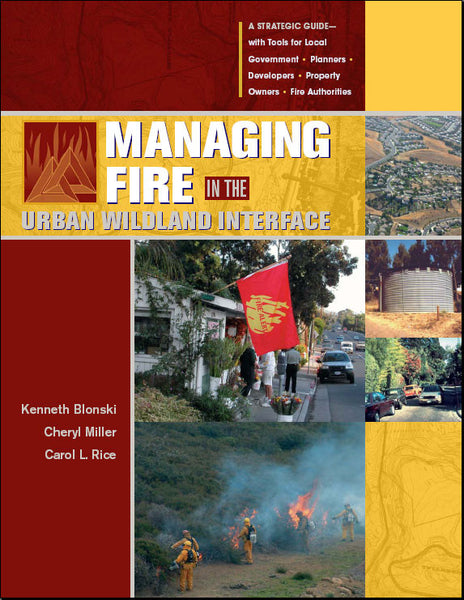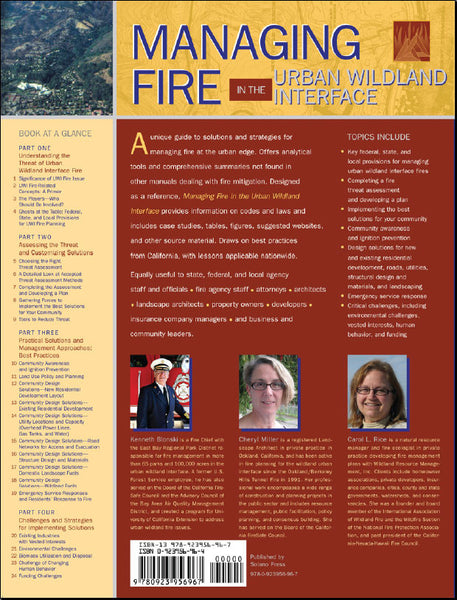Managing Fire in the Urban Wildland Interface
- Item# FM
- ISBN: 978-0-923956-96-7
- Copyright (c) 2010
- Paperback
- Price: $85.00
DESCRIPTION
A unique guide to solutions and strategies for managing fire at the urban edge. Offers analytical tools and comprehensive summaries not found in other manuals dealing with fire mitigation. Designed as a reference. Managing Fire in the Urban Wildland Interface provides information on codes and laws and includes case studies, tables, figures, suggested websites, and other source material. Draws on best practices from California, with lessons applicable nationwide.
Equally useful to state, federal, and local agency staff and officials; fire agency staff; attorneys; architects; landscape architects; property owners; developers; insurance company managers; and business and community leaders.
Managing Fire in the Urban Wildland Interface has been named winner of the 2011 Education Award from the APA (American Planning Association) California Northern Section and 2011 Outstanding Environmental Resource Document Award at the 2011 AEP (Association of Environmental Professionals) Annual Conference
COVERED TOPICS
- Key federal, state, and local provisions for managing urban wildland interface fires
- Completing a fire threat assessment and developing a plan
- Implementing the best solutions for your community
- Community awareness and ignition prevention
- Design solutions for new and existing residential development, roads, utilities, structural design and materials, and landscaping
- Emergency service response
- Critical challenges, including environmental challenges, vested interests, human behavior, and funding
CHAPTERS AT A GLANCE
PART ONE: Understanding the Threat of Urban Wildland Interface Fire
- Significance of the UWI Fire Issue
- UWI Fire-Related Concepts: A Primer
- The Players - Who Should Be Involved?
- Ghosts at the Table: Federal, State, and Local Provisions for UWI Fire Planning
PART TWO: Assessing the Threat and Customizing Solutions
- Choosing the Right Threat Assessment
- A Detailed Look at Accepted Threat Assessment Methods
- Completing the Assessment and Developing a Plan
- Gathering Forces to Implement the Best Solutions for Your Community
- Tools to Reduce Threat
PART THREE: Practical Solutions and Management Approaches - Best Practices
- Community Awareness and Ignition Prevention
- Land Use Policy and Planning
- Community Design Solutions - New Residential Development Layout
- Community Design Solutions - Existing Residential Development
- Community Design Solutions - Utility Locations and Capacity
- Community Desing Solutions - Road Networks for Access and Evaluation
- Community Desing Solutions - Structure Design and Materials
- Community Desing Solutions - Domestic Landscape Fuels
- Community Desing Solutions - Wildland Fuels
- Emergency Service Responses and Residents' Response to Fire
PART FOUR: Challenges and Strategies for Implementing Solutions
- Existing Industries with Vested Interests
- Environmental Challenges
- Biomass Utilization and Disposal
- The Challenge of Changing Human Behavior
- Funding Challenges
ABOUT THE AUTHORS
The authors of Managing Fire in the Wildland Interface offer expertise in a wide range of subject matters spanning from fire suppression, natural resource management, fire science, urban planning, landscape architecture, policy planning, with experience in both the private and public sector. They have delivered technical papers and presentations, both jointly and as individuals, to various audiences including local neighborhoods, the League of Cities, American Planning Association, National Fire Prevention Association, and the International Association of Fire Chiefs. It is the combination of these disciplines that make this book unique.
Kenneth Blonski is a Fire Chief with the East Bay Regional Park District responsible for fire management in more than 65 parks and 100,000 acres in the urban wildland interface. As a career U.S. Forest Service employee he served on the Redding Hot Shot Crew, as Fuels Management Officer on the Plumas and Lassen National Forests, Pacific Southwest Regional Fire Suppression Coordinator, Fire Planner for the region, Type I Operations Section Chief, and finally as Deputy Director Fire Management. He joined the University of California Extension to create a program that addresses urban wildland fire issues and has served on the Board of the California Fire Safe Council and the Advisory Council of the Bay Area Air Quality Management District.
Cheryl Miller is a registered Landscape Architect in private practice in Oakland, California. Since the Oakland/Berkeley Hills Tunnel Fire in 1991, she has been active in wildland urban interface fire planning. Her professional work extends to a wide range of construction and planning projects in the public sector. While managing multi-disciplinary teams to address complex issues, she adds her skills in resource management, public facilitation, policy planning, and consensus building. She has served on the Board of the California Fire Safe Council.
Carol L. Rice is a natural resource manager and fire ecologist in private practice developing fire management plans with Wildland Resource Management, Inc. Clients range from homeowner associations, private developers, insurance companies, cities, county and state governments, watersheds, and conservancies. She has been in practice for more than 30 years based in Alamo, California. She was a founder and board member of the International Association of Wildland Fire and the Wildfire Section of the National Fire Protection Association. She is the past president of the California-Nevada-Hawaii Fire Council.








